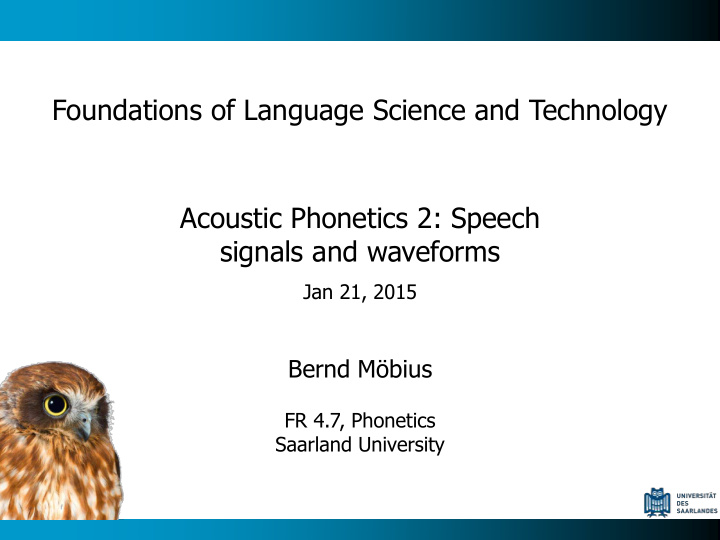



Foundations of Language Science and Technology Acoustic Phonetics 2: Speech signals and waveforms Jan 21, 2015 Bernd Möbius FR 4.7, Phonetics Saarland University
Acoustic communication � Prerequisites for acoustically based speech communication � sound production � sound perception � sound propagating medium � Basic acoustic properties of speech sounds � frequencies within the range of human auditory perception (20 – 20,000 Hz) � amplitude: displacement of an oscillation � perceived loudness � duration: perceptible minimum duration; duration of units of speech � (timbre)
Speech sounds and speech signals � Basic types of speech signals � quasi-periodic signals: sonority � vowels � sonorants (approximants, glides, nasals, liquids) � stochastic signals: frication noise � fricatives � plosive aspirations � transient signals – impulse � plosive releases � mixed excitation – voiced frication noise � voiced fricatives
Speech sounds and speech signals "Heute ist schönes Frühlingswetter."
Speech sounds and speech signals: vowels "Heute ist schönes Frühlingswetter."
Speech sounds and speech signals: sonorants "Heute ist schönes Frühlingswetter."
Speech sounds and speech signals: fricatives "Heute is schönes Frühlingswetter."
Speech sounds and speech signals: plosives "Heute is(t) schönes Frühlingswetter."
Speech sounds...: voiced fricatives voiced? "Heute ist schönes Frühlingswetter."
Simple waveforms
Simple waveforms � Simple periodic oscillation: pure sine wave � cyclically recurring, simple oscillation pattern, determined by � fundamental period T 0 � amplitude A � phase � � Fundamental frequency [Hz]: 1 / fundamental period [s] F 0 = 1 / T 0
Simple waveforms � Phase relation � two sine waves of same frequency and amplitude, but temporally displaced maxima, minima, and zero crossings � phase shift (here: angle 90º)
Simple waveforms � Frequency differences � two sine waves of same amplitude and phase, but different frequency (here: 1 vs. 2 Hz)
Complex waveforms � Complex periodic signals � cyclically recurring oscillation patterns � composed of at least two sine waves � fundamental frequency = 1 / complex fundamental period � Form of resulting complex wave depends on frequency, amplitude and phase relations between component waves
Complex waveforms � Complex waveform: 2 components � two sine waves (100 Hz, 1000 Hz) with same phase and different amplitude (left) � complex wave (right) resulting from addition of the two components � F 0 = 100 Hz
Complex waveforms � Complex waveform (red): 5 components � five sine waves (100, 200, 300, 400, 500 Hz) with same phase � only 3 lowest frequency components displayed
Complex waveforms � Complex waveform (red): 5 components � five sine waves (100, 200, 300, 400, 500 Hz) with phase shifts � only 3 lowest frequency components displayed
Power spectrum � Power spectrum (amplitude over frequencies) of the complex waveform composed of five components (see above)
Fourier analysis � Fourier analysis: power spectrum of 5 component wave (see above) � Fourier's theorem � every complex wave can be analytically decomposed into a series of sine waves, each with a specific set of frequency, amplitude and phase values
Fourier analysis and power spectrum � Differences between result of Fourier analysis and idealized power spectrum (see above): � broader peaks � additional peaks � Reasons for these differences: � Fourier analysis assumes infinitely long signal, whereas analysis is performed over 2 fundamental periods (quasi-periodic signal) � analog vs. digital signal representation
Discrete Fourier Transform � Discrete Fourier analysis (Discrete Fourier Transform, DFT) � digital Fourier analysis of complex signals, yielding a spectrum of sine wave components � transformation of data from time domain into frequency data � resolution parameters � sampling rate (e.g. 16000 Hz) � window size (length; e.g. 512 samples) � granularity of computed spectrum ca. 31 Hz (16000/512=31.25), with linear interpolation � trading relation (uncertainty principle) � good frequency resolution � poor time resolution � good time resolution � poor frequency resolution
Spectrogram � Analysis window size/length: � short temporal window : good time resolution � long temporal window: good frequency resolution � Types of spectrograms: � narrow band spectrogram (e.g. 50 Hz): good frequency resolution � wide band spectrogram (e.g. 300 Hz): good temporal resolution
From spectrum to spectrogram � Power spectrum: � snapshot taken at a specific instant of time in the speech signal � Spectrogram: � time as 3 rd dimension (beside frequency and amplitude) � x-axis: time [s] � y-axis: frequency [Hz] � "z-axis": amplitude [dB] (gray-scale or color coding) Let's go use Praat for further interactive demos... (exercise session on Friday!)
Thanks!
Recommend
More recommend